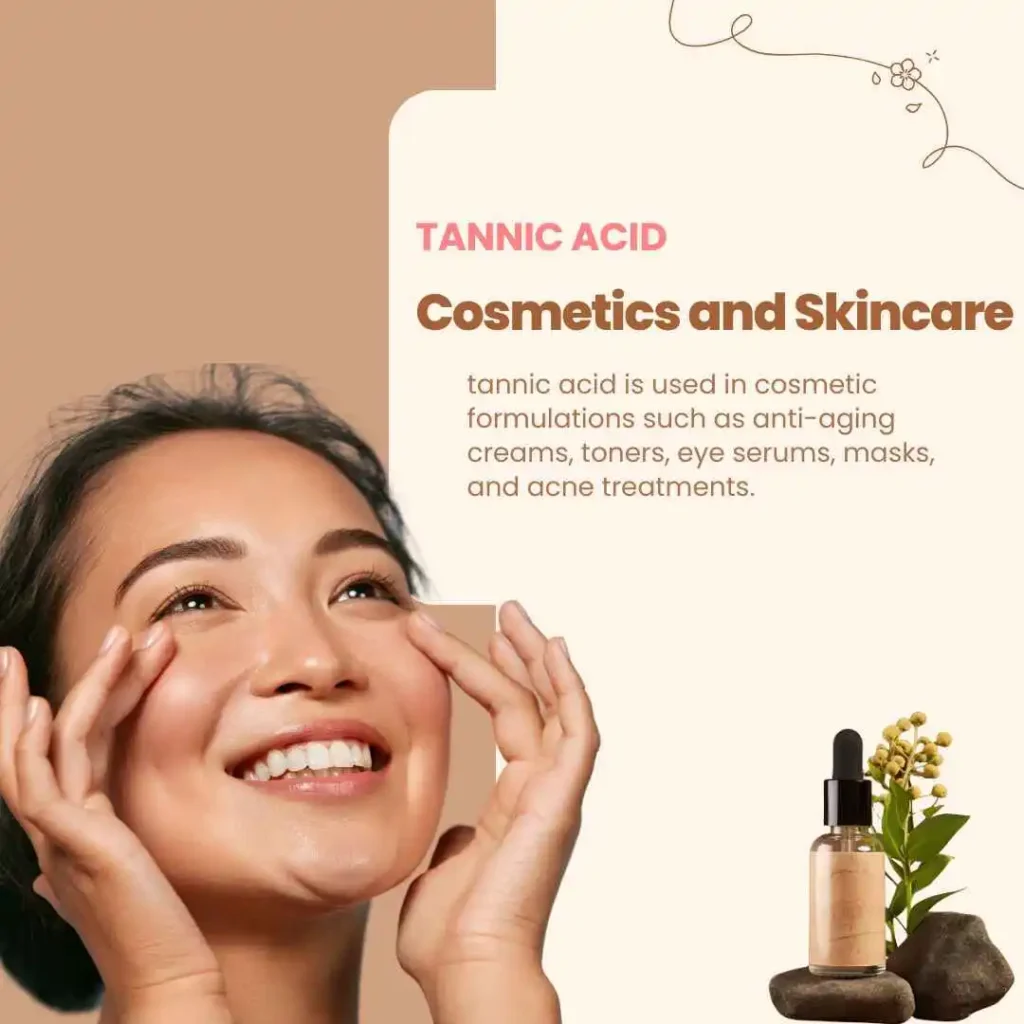In recent years, there has been a strong shift towards natural, plant-based ingredients in the cosmetics and skincare industry. One such ingredient gaining significant attention is tannic acid, a polyphenol derived from plants, fruits, and tree bark. Tannic acid enhances skin health, soothes inflammation, and protects against environmental stressors in cosmetic formulations due to its antioxidant, anti-inflammatory, and astringent properties.
In this blog, we explore what tannic acid is, how it works, and the growing role of tannic acid for skin in modern cosmetic science.

Tannic Acid Skin Benefits: Nature’s Gift to Healthy Skin
What is Tannic Acid?
Tannic acid is a type of hydrolyzable tannin found in various plant sources such as oak bark, witch hazel, chestnut, and certain fruits like grapes and pomegranates. Chemically, it is composed of gallic acid units and glucose, giving it potent antioxidant and astringent properties.
Historically used in medicine and leather tanning, tannic acid has now found a special place in cosmetics due to its bioactive profile and natural origin.
Why Tannic Acid is Used in Cosmetic Formulations
Cosmetic chemists and formulators are increasingly turning to tannic acid in cosmetic formulations for several compelling reasons:
- Antioxidant Protection
Tannic acid is a powerful antioxidant that protects the skin from oxidative stress caused by UV rays, pollution, and other environmental factors. This protection helps slow down premature aging and reduces the formation of fine lines and wrinkles.
2. Anti-Inflammatory Action
Tannic acid can calm irritated skin and reduce redness, swelling, and inflammation. It’s especially beneficial in formulations targeting sensitive, acne-prone, or rosacea-affected skin.
3. Astringent Properties
Due to its astringent nature, tannic acid helps tighten the skin, reduce pore size, and control excess oil. This makes it ideal for use in toners, cleansers, and pore-refining serums.
4. Antibacterial & Antifungal
Tannic acid also exhibits antimicrobial activity, making it suitable for formulations aimed at treating acne, minor cuts, or infections.
5. Enhances Skin Barrier Function
When used regularly, tannic acid helps strengthen the skin barrier, improving moisture retention and skin resilience.
Because of its properties, cosmetic formulators use tannic acid in products like anti-aging creams, toners, eye serums, masks, and acne treatments.
Tannic Acid Skin Benefits: Nature’s Gift to Healthy Skin
Let’s break down the specific tannic acid skin benefits and how it improves the overall condition and appearance of the skin:
1. Reduces Fine Lines and Wrinkles
Tannic acid neutralizes free radicals that contribute to collagen breakdown, thus maintaining skin elasticity and firmness. With regular use, it can visibly reduce the signs of aging.
2. Controls Acne and Breakouts
Thanks to its antibacterial and anti-inflammatory properties, tannic acid is effective in reducing acne lesions, calming active pimples, and preventing future breakouts.
3. Minimizes Pores
Its astringent nature allows it to contract skin tissues, giving the skin a smoother texture and reducing the visibility of enlarged pores.
4. Soothes Irritated Skin
Tannic acid is excellent for calming conditions like redness, irritation, or mild eczema. It acts as a natural skin soother without the side effects of synthetic ingredients.
5. Brightens Complexion
Regular use of tannic acid-infused products can lead to a brighter, more even-toned complexion due to its antioxidant and melanin-inhibiting properties.
How Tannic Acid is Used in Skincare Products
The versatility of tannic acid for skin means it can be incorporated in various types of cosmetic products:
- Toners & Mists: Used for tightening pores and refreshing skin
- Serums & Essences: Targeted application for acne control or anti-aging
- Face Masks: Often used with clays or plant extracts to detoxify and nourish skin
- Eye Creams: Helps reduce puffiness and firm delicate under-eye skin
- Moisturizers: Combats oxidative stress and boosts hydration.
Often, tannic acid is paired with other bioactives like niacinamide, vitamin C, or green tea extract for a synergistic effect.
Is Tannic Acid Safe for All Skin Types?
Yes, generally, tannic acid is safe for topical use in cosmetic formulations. However, as with any active ingredient, concentration and skin sensitivity must be considered.
- Normal to Oily Skin: Tannic acid works exceptionally well due to its pore-tightening and oil-controlling effects.
- Dry Skin: It should be paired with hydrating ingredients to prevent over-drying.
- Sensitive Skin: Patch testing is recommended, though tannic acid’s anti-inflammatory nature is usually well-tolerated.
Always consult a dermatologist if you have concerns or pre-existing skin conditions.
Why Brands are Moving Towards Natural Ingredients like Tannic Acid
Today’s consumers are more conscious about what goes into their skincare products. Natural, non-toxic, and eco-friendly ingredients are highly sought after, and tannic acid ticks all the boxes:
- Plant-derived
- Biodegradable
- Low risk of irritation
- Effective across various skin concerns
This shift is driving demand for botanical actives in luxury, organic, and dermatological skincare brands alike.
Final Thoughts
Tannic acid offers much more than traditional herbal extracts—it delivers visible results as a scientifically supported, multifunctional ingredient.
Whether you’re looking to fight acne, signs of aging, or just want a clearer complexion, tannic acid for skin can be a game-changing addition to your skincare routine.
As more research emerges and natural skincare continues to dominate the market, cosmetic brands are using tannic acid in formulations more than ever before—and for good reason. It’s effective, safe, and aligns perfectly with the modern skincare movement toward clean and green beauty.
